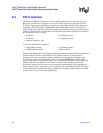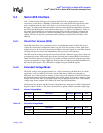
Design Guide 29
4.5 Trace Impedance
All signal layers require controlled impedance of 50 Ω +/- 15%, microstrip or stripline where
appropriate, unless otherwise specified. Selecting the appropriate board stack-up to minimize
impedance variations is very important. When calculating flight times, it is important to consider
the minimum and maximum trace impedance based on the switching neighboring traces. Use wider
spaces between traces, since this may minimize trace-to-trace coupling, and reduce cross talk.
All recommendations described in this document assume a T
wid
5mil50Ω signal trace, unless
otherwise specified. When a different stack up is used the trace widths must be adjusted
appropriately. When wider traces are used, the trace spacing must be adjusted accordingly
(linearly).
It is highly recommended that a 2D Field Solver be used to design the high-speed traces. The
following Impedance Calculator URLs provide approximations for the trace impedance of various
topologies. They may be used to generate the starting point for a full 2D Field solver.
http://emclab.umr.edu/pcbtlc/
http://www.westak.com/techcenter/imped/
The following website link provides a useful basic guideline for calculating trace parameters:
http://www.ultracad.com/calc.htm
Note: Using stripline transmission lines may give better results than microstrip. This is due to the
difficulty of precisely controlling the dielectric constant of the solder mask, and the difficulty in
limiting the plated thickness of microstrip conductors, which may substantially increase cross-talk.
4.5.1 Differential Impedance
The Serial ATA standard defines a 100 ohms differential impedance. This section provides some
basic background information on the differential impedance calculations. In the cross section of
Figure 9 shows the cross section of two traces of a differential pair.
To calculate the coupled impedance requires a 2x2 matrix. The diagonal values in the matrix
represent the impedance of the traces to ground and the off-diagonal values provide a measure of
how tightly the traces are coupled. The differential impedance is the value of the line-to-line
resistor terminator that optimally terminates pure differential signals. The two by two matrix is
shown below as:
Figure 9. Cross Section of Differential Trace
Ground reference plan
e
Example 1. Two-by-two Differential Impedance Matrix
Zo
Z11 Z12
Z21 Z22
=


















